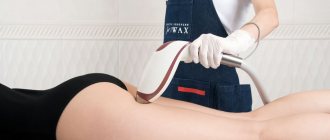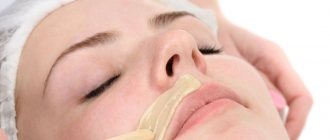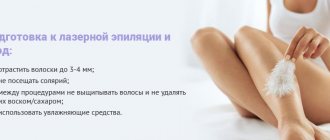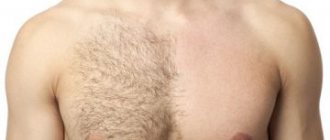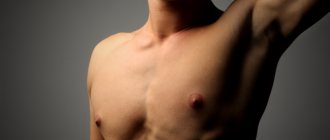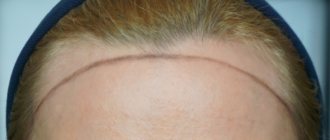Sugaring is a method of removing unwanted body hair. It attracts with its effectiveness, long-lasting results and low cost. The sugar paste for the procedure is made from natural products that do not cause allergic reactions. In addition, the process can be carried out at home. The essence of the method is simple: warm caramel is applied to the skin, after hardening, it is removed along with the hairs and follicles. However, this is not the only thing that attracts women to use sugar paste. How long does the effect last?
After the procedure, the hair grows slowly, becomes thin and light. Manipulations with caramel do not cause burns and remove hair of varying lengths, thicknesses and hardness. The method is suitable for all areas of the body. Recommended for sensitive types, it is the least traumatic hair removal option. With each session, growth slows down, and pain is almost not noticeable.
Phases and stages of body hair growth
The smoothness effect depends on the stage of hair growth. Each person has an individual hair root life cycle. The long stage will eliminate frequent hair removal. There are three stages of growth:
- anangen;
- catagen;
- telogen
The first option is the active growth phase. When hair is removed, the source of nutrition for the roots is cut off and the follicle membrane is destroyed. Next comes the second intermediate stage. During the catagen period, hair moves from active growth to calmness. The bulbs do not divide and become keratinized. This may last for several weeks. Then the hairs fall out, and new ones develop in their place, sometimes up to 3 in one follicle. If after sugaring they begin to grow quickly, it may be that some of the removed ones were already in the telogen stage . They appear on the surface after 2-3 days. Sometimes during the procedure, “blood dew” is visible on the skin. Don't panic. If the root is thick, the caramel damages its mouth with the blood vessels of the papilla, and a small amount of blood is released on the skin. This phenomenon occurs when sugaring is performed in the anagen stage. This goes away with subsequent procedures.
Contraindications and side effects
Despite the large number of advantages of sugaring, this method of depilation has contraindications for use:
- It is not recommended to use sugaring during pregnancy. During this period, the woman’s body is sensitive to any pain. Depilation can lead to unpleasant consequences.
- For varicose veins, sugar depilation can be performed at an early stage of the disease. It is advisable to consult your doctor before using it.
- People with diabetes should not undergo sugaring, because during the procedure, the sugar contained in the cosmetic mixture will enter the patient’s blood through the pores of the skin. Another reason for prohibiting depilation is that such patients have poor healing of any skin damage.
- Sugar depilation should not be performed on people with epilepsy. The procedure may cause a person to have a seizure.
- Some components of the paste may cause an allergic reaction in the client.
- Sugar depilation should not be performed if there are any skin lesions, papillomas, or tumors.
- It is also not recommended to do it after visiting a solarium or undergoing chemical peeling.
If depilation is performed incorrectly using sugaring, bruises and ingrown hairs may appear on the human body. If hygiene rules are not followed, acne and skin rashes may occur.
Why does sugaring slow down hair growth?
The visibility of hairs after the procedure will appear only after 2-3 weeks, in some cases after 4. This depends on the individual characteristics of the body. Sugar paste tends to slow down growth. Under the influence of natural ingredients, including recipes with citric acid at home, the structure of the rod changes. It becomes thin, light and begins to grow slowly. The result becomes noticeable after 2-3 sessions. The caramel is removed along the growth line, so the skin does not need to restore its protective functions. During the procedure, the follicle does not experience stress, and there is no irritation left on the skin. Manipulation with the paste activates blood circulation in all layers of the eidermis, removes dead skin cells and ensures smoothness. Proper care of the treated area after depilation will ensure a long-lasting effect.
What is laser hair removal
Laser hair removal is a medical procedure aimed at removing excess hair using a laser. The peculiarity of the manipulation is the destruction of the hair bulb (follicle) containing the natural dye melanin. Laser beams, passing through the skin, act on the pigment. As a result, melanin heats up and destroys neighboring areas of glands, blood vessels and hair growth areas. The nutrition of the hair follicles stops, the hairs become thinner and fall out. After epilation, regrowth of vegetation in this place is impossible.
How long does the result of sugaring last, how long is the effect?
The time it takes for a new hair to appear in different areas can last from 14 to 30 days. This largely depends on the proximity of blood capillaries to the surface of the skin, as well as the individual characteristics of the body. Time intervals for different zones:
- armpits – 10-15 days;
- bikini – 20-25;
- eyebrows – 12-15;
- legs, arms – 25-30;
- face - 20-28.
Different growth rates in certain areas of the body make it possible to treat the skin with sugar paste at any time. If the procedure is performed incorrectly or the caramel was chosen incorrectly, the effect of smooth skin is reduced for several days. Some women can do sugaring once a month. Others resort to the procedure more often. This factor depends on genetic predisposition and hormonal changes. You can find out about hair removal according to the lunar calendar 2022 in this article.
What determines the duration of the result?
It all depends on following the technique of applying and removing sugar paste. On average, this ranges from 20 to 30 days. However, the result should not be assessed immediately after the first session. After each subsequent procedure, the smoothness time increases. Reasons for the long-term effect:
- professional qualities of the master;
- correctly selected mass density;
- careful skin care before and after hair removal;
- regular scrubbing and moisturizing;
- compliance with all recommendations of the cosmetologist between sessions.
If the work was carried out with weak skin tension, the hairs break off near the root. This can lead to an ingrowth problem. You can find out how the photoepilator works by following the link.
How quickly does hair grow back after the first time?
No master can answer this question. The speed of growth does not depend on the chosen method. Reasons for accelerated growth:
- processing area;
- changes in hormonal levels;
- genetic and gender predisposition.
Experts note that some areas remain smooth longer after hair removal, while others quickly become overgrown. Hair appears on the face after a week. In the armpit area - after 7-10 days. Bikini area - 14-18 days, deep bikini - up to 30 days. “Spikes” appear on the arms and legs after 20-25 days. Hairs that appear after the first time can be removed at any time. It is better to carry out the procedure at home. This way you can save your family budget and do hair removal in the evening so that your skin can “rest” overnight.
How many times do you need to do sugaring for hair to stop growing?
After the first procedure, growth slows down. The reason is the natural composition of caramel and the professionalism of the master. With regular sessions, the hairs lighten and become thinner. The manufacturer adds substances to some pastes to stop hair from growing. However, sugaring does not completely stop growth. You can find out how to properly do sugaring on your feet at home here.
Procedure
The manipulations are performed by a specialist who is familiar with all the rules of the laser procedure. Before conducting the course, the cosmetologist finds out whether the client has chronic diseases, what medications are taken, and whether there are allergic reactions to gel compositions.
The area to be treated is wiped with a disinfectant, then a cooling gel is applied. To protect against burns, use a device with a cooling attachment. The doctor and patient wear glasses that protect their eyes from laser flashes. The doctor selects the power and type of laser that corresponds to the client’s skin phototype, color and hair stiffness. Moves the device that creates light beams across the selected area. After surgery, an antiseptic is applied to the treated surface.
Types of lasers used for hair removal
The effectiveness of light radiation depends on the type of laser. The following types of devices are often used in salons:
- Alexandrite laser – not used on dark skin due to lack of effect. Removes dark and light brown hair on fair skin, but does not work on red and gray hair. Gets rid of ingrown hairs. Sometimes causes lightening or darkening of the skin.
- Neodymium laser – removes dark and light hair from pale and tanned skin. It stops feeding the follicle, affecting not the melanin, but the blood network of the hair follicle. Used for the formation of blackheads after shaving and on irritated skin. Automatically recognizes hairs to be removed. The treatment area is affected pointwise. After 7 sessions, 95% of dark or 80% of light (gray) hairs disappear from the treated area.
- Diode laser is an innovative model with great functionality. Passing through the skin, it affects melanin and follicular vessels, easily removes hair on tanned and dark skin prone to hyperpigmentation, without causing irritation. The radiation power is adjustable.
Sometimes they use a ruby laser - an outdated model that only removes dark hair on light skin.
How to choose a product to slow down hair growth
It is recommended to use inhibitors for this function. They inhibit the appearance of new instances, but do not delete them. By affecting the embryo at the root, they inhibit cell division and locally reduce the amount of protein. After using them, the hair becomes thin and light. Subsequent epilations are simplified and the time required for them is reduced. However, the use of inhibitors should be constant. There will be no effect with a single use. Three groups of growth inhibitors:
- cosmetic;
- pharmacy;
- homemade.
The most popular cosmetic cream. It is applied within 2 weeks after the procedure. The brand is chosen at your discretion. The drug nourishes the skin, relieves irritation, and moisturizes. Recommended for all types. You can purchase pharmaceutical products or prepare the mixture at home.
Inhibitors are not recommended for use in girls under 14 years of age.
Bikini area
Thanks to scrubbing sugar particles, the skin exfoliates, because the bikini area also needs care and proper cleansing. If everything is done correctly, there should be no irritation or inflammation left, but everyone's skin is very different. If you do this procedure regularly, the hairs will become thinner and lighter, which will significantly reduce pain during subsequent depilation. How long does bikini sugaring last? You can enjoy the effect of perfect smoothness from one to three weeks.
Answers to frequently asked questions
Before visiting a salon or using the paste yourself, you should study the pros and cons. We invite you to consider questions that hair removal clients often ask.
How many days does it take to grow hair for sugar removal?
It is not recommended to allow a large length, otherwise they will get confused during the procedure. This will lead to their breaking off and partial removal. Short hairs are also difficult to remove. Before the procedure, they are grown for several days to 3-5 mm so that the paste is carefully fixed on them. This will remove the caramel along with the hair follicles.
How long should you grow it?
The amount of hair on the body and its structure is always an individual factor. Sometimes this affects the pain and difficulty of hair removal. To make the task easier, you should grow your hair to the desired length. For all areas it ranges from 3 to 5 mm. In the deep bikini area, 6 mm is allowed. Only in this case will the adhesion to the caramel be good and the hairs will be removed with the follicle when the skin is stretched. You should not calculate the length on your hands. In this zone, removal occurs quite easily. Long ones are usually trimmed with a trimmer or small scissors right before applying the paste.
Why does coarse hair grow after sugaring?
Such cases are rare. The main factor behind this problem is improper handling. Hard ones begin to grow back after 3-5 days. They actively make their way out of blackheads. This is why it is important to wax regularly so that the hair structure becomes thinner and lighter. After this, they grow evenly and are removed simultaneously. You can find out how to properly do sugaring at home here.
Why does hair grow unevenly?
The first reason why hair grows unevenly is improper sugar hair removal. Perhaps, when removing the paste, the skin was not stretched properly so that the hairs were pulled out along with the bulb. “Stumps” or black dots may remain under the skin - hair that is in a dormant stage. After 3-4 days they begin to germinate, but at different rates. To solve the problem, it is worth carrying out the procedures regularly. After several sessions, the hairline becomes smoother and the blackheads disappear.
How to even out hair growth, what to do
To do this, you need to carry out at least 3 procedures using sugar paste. For removal, it is better to use the “mix” technique. The soft paste is applied to the skin in a thin layer. A layer of thick caramel is placed on top, left for 15-20 seconds and removed. If hairs remain, they are removed with tweezers. There must be at least 14 days between sessions. The course duration for leveling is 30-35 days. After this, sugaring is carried out once a month with a length of 1 to 3 mm. Inhibitors will help level them out.
How to deal with ingrown hairs and acne after sugar depilation
Usually, removing the paste along the growth line prevents the hairs from breaking off and bending. Often, hairs grow in after epilation if you do bikini sugaring at home. This is facilitated by wearing tight underwear. In addition, if skin care recommendations are not followed after sugaring, ingrown spots may also appear. How to deal with this? Regular scrubbing and anti-growth creams can minimize the problem of ingrown hairs after sugaring in the bikini area and acne.
Introduction
To understand how long the effect of sugaring lasts, let’s look at the principle of its implementation. The sticky sugar mass adheres tightly to the hairs and, with a sharp tug, pulls them out of the bulbs. Sugaring is similar to other means of depilation, such as wax, but due to its aqueous composition it is less damaging to the skin.
The time of the result also depends not only on the skills of the specialist and the chosen composition, but also on the treated area, because hair grows completely differently in the bikini area, legs, arms and armpits.
Special creams to prolong results
Like any procedure, this one has its own characteristics, which not everyone knows about. That is why, despite its simplicity, not everyone can achieve the effect of perfectly smooth legs after sugaring.
To achieve the long-term effect of smooth legs, you need to:
- Prepare a liquid, amber-colored sugar mixture like honey.
- You can check the readiness of the paste by dropping it into a glass of cold water: if it hardens immediately, it means that the technology has been followed.
- Apply the paste to the skin when the temperature of the viscous liquid reaches 30°C (after natural cooling).
- After depilation, use special creams that slow down hair growth.
It is not surprising that this method is incredibly popular among women, because it combines many positive aspects. The main one is the long-lasting effect. Of these types of depilations, it is the most effective, since it guarantees that unwanted hairs will not grow for an average of 20 days.
